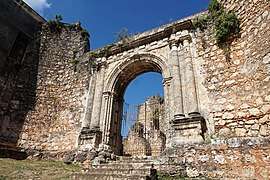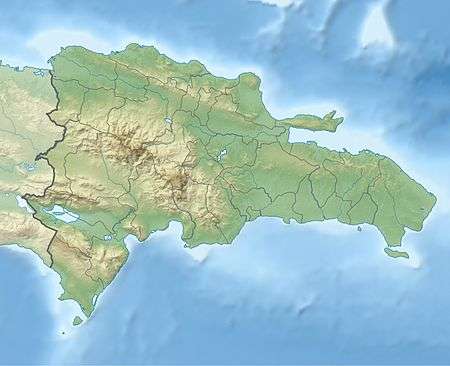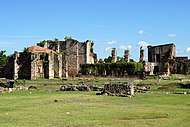Monasterio de San Francisco
Monasterio de San Francisco in Santo Domingo de Guzmán, Dominican Republic, is a monastery that was built between 1509–1560,[1] with the arrival of the Franciscan fathers. The ruin is one of the most important of the city. It is located in the Colonial City of Santo Domingo and are part of UNESCO's 1990 declaration of the Colonial City as a World Heritage Site. The monastery was recognized by UNESCO for being the first and oldest monastery built in the Americas.[2]
| UNESCO World Heritage Site | |
|---|---|
 Ruins of the Monasterio de San Francisco | |
| Location | Santo Domingo, Dominican Republic |
| Part of | Colonial City of Santo Domingo |
| Criteria | Cultural: (ii), (iv), (vi) |
| Reference | 526 |
| Inscription | 1990 (14th session) |
| Coordinates | 18°28′22″N 69°53′12″W |
 Location of Monasterio de San Francisco in the Dominican Republic | |
History
The Monastery of San Francisco was one of the works of Nicolás de Ovando. Construction began with the arrival of the Franciscan fathers around 1509. It was the first monastery in the New World. The monastery was later hit by a hurricane. Construction began on the main part of the church in 1544 and was completed on July 23, 1556. In 1586 it was sacked by Francis Drake. Repairs were completed in 1664, but according to historians, the building was damaged by earthquakes in 1673 and 1751.
Alonso de Ojeda was buried at the main entrance to the monastery. His remains were moved to the former Convento Dominico on October 12, 1942. Also found were the remains of Bartholomew Columbus. After the Battle of Palo Hincado (1808) against the French, followed the siege of Santo Domingo. The French cut the church vaults and built a wooden artillery platform which soon collapsed after firing the cannons.[3]
The building was used as a mental asylum from the 1880s until the 1930s. On September 3, 1930, Hurricane San Zenón caused a lot of damage, and the buildings were never reconstructed.[4] Currently, the ruins are used for social and cultural events and are cared for and protected by law and by the county of Efemérides. It is also one of the key buildings included in the official 1990 World Heritage Site declaration of Santo Domingo's Ciudad Colonial.
Gallery

Main entrance to the church 
Nave of the main church 
Exterior view of the apse of the main church 
Exterior view of the Chapel of the Third Order 
Interior view of the Chapel of the Third Order 
Rib vaults of the Chapel of the Third Order 
Night view of the main gate 
Panoramic view of the monument
References
- "RUINS OF THE SAN FRANCISCO MONASTERY". colonialzone-dr.com.
- "Colonial City of Santo Domingo. Outstanding Universal Value". UNESCO World Heritage Centre website.
- Ruinas de San Francisco: Entre el rescate y el abandono
- "Lonely Planet review for Monasterio de San Francisco". Lonely Planet website. Retrieved July 4, 2011.
External links
